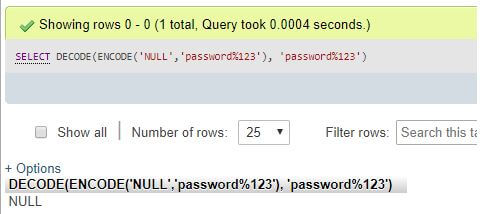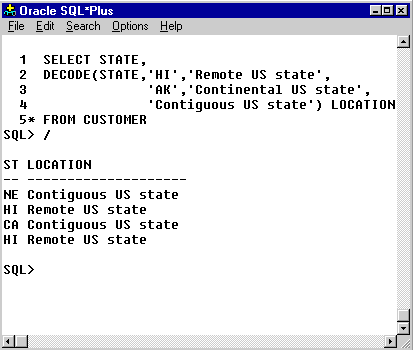
MENU_ITEMĪ SELECT statement along with the Decode function may be used as follows: SELECT The values being evaluated will be the values for the DESCRIPTION column. The table for the shop is called Smoothie_Tbl and contains columns for menu item number, description, and price. In this scenario, a smoothie shop is replacing all of the peanut butter smoothies with almond butter smoothies. The following is an outline of the fundamental syntax for the Case function: CASE when Īs a demonstration of the application of the syntax summaries provided above, the following is an example of a value being overridden after a Decode or Case function is implemented: The operations and syntax for the Case and Decode functions are similar, but the Case function has more capabilities than the Decode function. There is also an updated version of the Decode function, called the Case function. The following is an outline for the fundamental syntax for the Decode function: You can learn more about different types of queries in SQL by exploring a tutorial on Udemy. Using a CrossTab query along with a Decode function is one method that utilizes the organizational benefits of the Decode function. A CrossTab query involves operations that are common with a Select statement, but also have added functionality for distributing data in a table. The Decode function can be used along with Select statements for queries, such as a CrossTab query. Conditions that are included in a Decode function include conditions such as the Equal(=) condition and Less Than() condition. Additionally, the Decode function can help with organization of a table as it can create new columns used for data distribution based on results from evaluations. Not only does the Decode function assist with data handling, it also combines the benefits of indexes. The Decode function evaluates an expression to determine which criteria options are met and then performs an action (such as overriding a value) based on the evaluation results the function will perform these steps using a process that involves cases for different criteria.Īn index for a table can help improve searches and optimizations. If you are not familiar with If-Then-Else statements or the Decode function in SQL, that is also okay, because this article will provide explanations and examples for the SQL Decode function. The maximum number of components in the DECODE function, including expr, searches, results, and default, is 255.If you are familiar with If-Then-Else statements, then you may find that the concepts involved with an If-Then-Else statement can be somewhat similar to concepts involved with the SQL Decode function. If expr is null, then Oracle returns the result of the first search that is also null. In a DECODE function, Oracle considers two nulls to be equivalent. If the first result has the data type CHAR or if the first result is null, then Oracle converts the return value to the data type VARCHAR2. Oracle automatically converts the return value to the same data type as the first result.


Oracle automatically converts expr and each search value to the data type of the first search value before comparing. Consequently, Oracle never evaluates a search if a previous search is equal to expr. The database evaluates each search value only before comparing it to expr, rather than evaluating all search values before comparing any of them with expr. Oracle Database uses short-circuit evaluation. The search, result, and default values can be derived from expressions. If the first search-result pair are numeric, then Oracle compares all search-result expressions and the first expr to determine the argument with the highest numeric precedence, implicitly converts the remaining arguments to that data type, and returns that data type.

The string returned is of VARCHAR2 data type and is in the same character set as the first result parameter. expr, search, and result can be any of the data types CHAR, VARCHAR2, NCHAR, or NVARCHAR2. If expr and search are character data, then Oracle compares them using nonpadded comparison semantics.
The arguments can be any of the numeric types ( NUMBER, BINARY_FLOAT, or BINARY_DOUBLE) or character types. If default is omitted, then Oracle returns null. If no match is found, then Oracle returns default. If expr is equal to a search, then Oracle Database returns the corresponding result. Description of the illustration ''decode.gif''ĭECODE compares expr to each search value one by one.


 0 kommentar(er)
0 kommentar(er)
